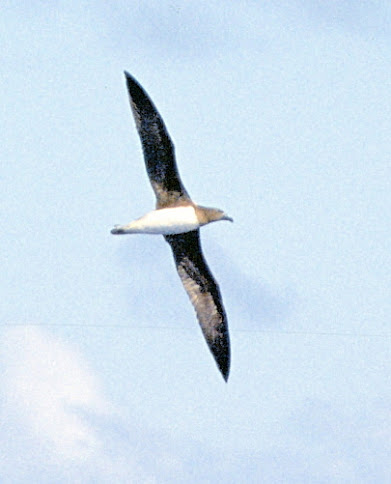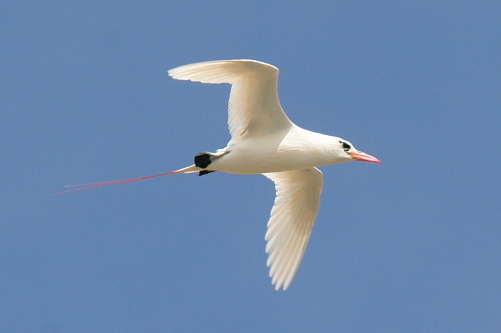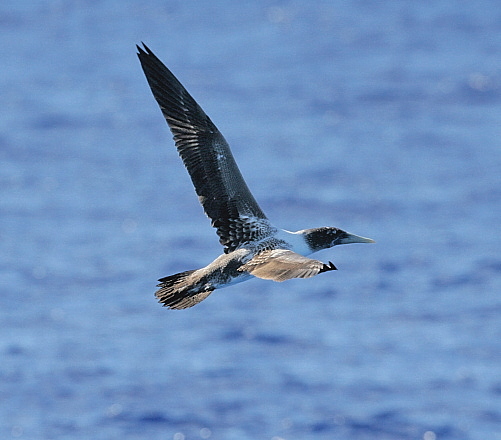POLYNESIAN & PITCAIRN ISLAND TRIP REPORT
4TH JUNE 2006 TO 21 JUNE 2006.
J.F. COOPER
The photographs were taken by myself and Chris Collins who had a new camera and lens.

ITINERARY
4 June Leave Heathrow to Papeete, Tahiti on Air New Zealand flight via Los Angeles.
5th June Arrive Papeete Tahiti, at 05.40 hrs, transferred to Hotel Mandarin before departing with group to Papehue Valley for morning birding. Then drove along coastal route, and explored another inland wooded valley just in from the coast.
 Arriving at the Papehue Valley Nature Reserve, Tahiti.
Arriving at the Papehue Valley Nature Reserve, Tahiti.

Road leading to the Papehue Valley Nature Reserve, Tahiti.

The Swiftlet gorge in Papehue Valley, Tahiti.
6th June Early flight at 05.50 hrs from Papeete, Tahiti via Hao Island to Mangareva Island (Gambier Islands). Walked along Island road, before boarding the "Bounty Bay” catamaran, owned by Pacific Expeditions. Departed Mangareva Island at 16.30 hrs to start the journey to Pitcairn Island.

Our plane from Tahiti to Mangareva Island.

Our flight stop over at Hao Island.

Leaving Hao Island.

Mangareva Island.


The boat crew.

The birders including Tony Quinn and Chris Collins.
 Leaving Mangareva Harbour on the "Bounty Bay"
Leaving Mangareva Harbour on the "Bounty Bay"
 Sunset as we left Mangareva Island.
Sunset as we left Mangareva Island.
7th June All day at sea heading towards Pitcairn Island.
8th June All day at sea heading towards Pitcairn Island arriving at mid-night.
9th June All day birding on Pitcairn Island, departing in the evening for Henderson Island.


 Coastal Views of Pitcairn Island, with the sea looking rough, as we were going into land.
Coastal Views of Pitcairn Island, with the sea looking rough, as we were going into land.
 We transferred into the landing craft to land on Pitcairn.
We transferred into the landing craft to land on Pitcairn.
 The Landing Quay on Pitcairn.
The Landing Quay on Pitcairn.

Pitcairn Island jetty



Several Views taken on Pitcairn Island

Wild flowers on Pitcairn Island.
 A Rough sea when departing to Pitcairn Island.
A Rough sea when departing to Pitcairn Island.
10th June All morning at sea heading towards Henderson Island arriving at mid-day. Toured around the island, before anchoring off Henderson Island for the night.
11th June Anchored just off-shore from Henderson Island all morning waiting for tide, before landing on Henderson for just 2 hours. Left Henderson Island around 17.00 hrs towards 40-mile reef on our way back to Pitcairn Island.




 Arriving at Henderson Island with a rough sea..
Arriving at Henderson Island with a rough sea..
Large waves breaking over the beach.
At long last we find a calm beach and sea so we could land.
Our landing beach on Henderson Island.
Birding the beach area on Henderson Island, after we had landed
Scenic view taken on Henderson Island. taken by C. Collins.
The Bounty Bay anchored off Henderson Island.
JFC's tidy lower bunk?? on the Bounty Bay.
12th June All day at sea, chummed over the 40-mile reef and then continued towards Pitcairn Island arriving at 17.00 hrs where we anchored overnight.
13th June Anchored all morning off Pitcairn Island, while we took on fresh water, departing late morning and headed out towards Oeno Atoll.
14th June Arrived Oeno Atoll at 2.00 am. Too rough to land and spent the day anchored off Oeno before departing after dusk for Morane Island.
Anchored off shore, time to move onto Oeno Atoll
Arriving at Oeno Atoll, but just too rough to land on shore.
Big waves still just off shore.
Some impressive waves coming over the reef at Oeno Atoll (taken by CC).
Oeno Atoll with its breeding sea-birds flying above the Island, we were disappointed as
we were unable to land as it would have been very good with so many sea-birds flying over the island.
JFC getting a good sun-tan off Oeno Atoll.
15th June All day at sea heading towards to Tuamotu Islands.
16th June All day at sea, explored over the Portland Banks, which are in places just 20 metres deep. Chummed this area.
17th June Continued our slow progress to Morane Island, finally arriving at 15.00 hrs.Toured along the coast of the Island, and anchored just offshore for the night.
Views of the Morane Islands
Good numbers of islands off-shore.
Morane Islands home to the Tuamotu Sandpiper.
Proved to be just too rough to land over the coral reef which surrounds the islands.
Pterdromas were flying all the time over the Islands.
We anchored overnight to a brillant sunset over the Pacific.
18th June To rough to land. So we again toured along the coast birding from the boat. Left Morane Island for our journey back to the Gambier Islands at 11.00 hrs.
19th June Arrived back to Mangareva Island at 11.00 hrs and walked along coast road. Cruised then the lagoon from 15.30 hrs until after dark visiting several nearby Islands. Anchored in harbour of Mangareva Island overnight.
Returning back to Mangareva Harbour.
Five views taken on Mangareva Island, Tony Q. and myself landed on the main Island
and had a walk around the Island, but virtually very few birds were seen.
Another cruise out into the Gambier Lagoon with offshore Islands, but still no sea-birds seen.
Islands in the Gambier Lagoon off Mangareva Island
Sunset over the Gambier Islands.
20th June Disembarked from the “Bounty Bay” at 09.00 hrs. Caught flight back to Papeete, Tahiti and the Air New Zealand flight back to Heathrow via Los Angeles, where we saw Western Gulls. Arriving back at Heathrow at 10.30 hrs BST on the 22nd June.
The Bounty Bay arriving back in one piece to Mangareva Harbour.
Acknowledgements: I would like to thank Chris Gaskill for organising this extended pelagic, Chris Collins for his company and the use of many of his superb photographs, I have used Chris's initials (CC) under his photographs used in this report, and Tony Quinn who invited me onto this trip, and the many hours we spent together and for the many discussions concerning Pterdroma identification.
SYSTEMATIC LIST.
Wandering Albatross – Diomedea exulans
A juvenile, probably 2nd/3rd calendar year bird, circled around our boat for some 15 minutes on the 13th giving excellent close views.
Considered Vulnerable by Birdlife International (2000), due mainly to longline fisheries.
Juvenile Wandering Albatross near Pitcairn Island





Juvenile type Wandering Albatross. (CC)
We were probably lucky seeing a Wandering so far North, at this time of the year.
Northern Giant Petrel – Macronectes halli
1-2 seen on the 14th with the darker swollen tip to the bill well seen, on one of the birds,
but the second bird was a sickly looking immature all dark brown bird with a broken leg,
which was attracted to our chumming. There was some debate on its identification as the
whole of the bill appeared ivory white coloured with just a thin blackish edge to the tip of
the bill.
Blackish tip to the bill showing fairly well.
Northern Giant Petrels taken by (CC).
Immature Northern Giant Petrel with a dead Red-tailed Tropicbird.(CC)
Tahiti Petrel – Pterodroma rostrata
This large, long-winged, large billed, Pterodroma was recorded on 4 dates as follows:
5 on the 7th, 9 on the 8th, 2 on the 10th with 1 on the 16th.
Tahiti Petrels taken after we left Mangareva Island.
Catching the evening sun-light. (CC)
The all dark upper-side.of Tahiti Petrels.
Tahiti Petrels (CC).
These pictures shows the very long straight wings and distinctive black under-wings with a pale area running down the centre of the under-wings. The flight is also distinctive being slower and more languid than Phoenix Petrel, with very straight wings.
Phoenix Petrel – Pterodroma alba
As with Herald Petrel listed below, much debate took place on the identification between
Phoenix and Herald Petrels, with fair numbers of birds seen showing a small amount of
white at the base on the primaries on the under-wings and it was suggested these birds
may be an unknown eastern race of Phoenix, although I considered many were probably
Heralds. I only felt certain of 3 birds, which I considered to be Phoenix, one on the 13th,
one on the 14th, and one on the 15th. These three, were seen well at close range with virtually
all black under-wings, one showing a good white leading edge to the underwing (see the first
picture below), and the others had a pale area on the underside of the primaries
which can be seen on the other pictures below. Otherwise they had black heads and
throats but lacking the long wings of Tahiti Petrel with the typical Pterdroma flight,
unlike Tahiti which has a much slower languid flight. Tahiti also shows in strong light
a narrow pale area running along the centre of the underwing.
Considered Vulnerable by Birdlife International (2000), due to its small breeding range
and predation by cats and rats.
Shows the white under-tail and dark under-wings well.
A good candidate for a Phoenix Petrel.
Herald Petrel - Pterodroma heraldica
Very confusing species, with many birds seen had far less extensive white on the
under-wings, and some observers felt some of these birds may be an eastern race of the
Phoenix Petrel, although I did not subscribe to this. Many of these individuals were left
unidentified, although in my opinion they were probably Heralds. Heralds usually showed a
well marked white stripe on the leading edge of the under-wing, which was more
striking than in Kermadec.
Numbers of identified Herald Petrels were as follows:
2 on the 7th, 4 on the 10th, 5 on the 12th, 50 on the 14th at Henderson Island, 1 on the 16th,
with 6 on the 17th.
A different Herald Petrel showing far more white on the leading edge of the underwing and white flash on the underwing of the primaries.
Another Herald Petrel type showing dark undertails. Good discussions on the identification of Herald Petrel, and it is certainly not easy. The above images all show extensive white at the base of the under-primaries, and also a white leading edge to the under-forewing, and dark undertails.
The above four pictures were considered to be of light phase birds. (CC)
Considered to be a dark phase Herald Petrel. (CC)
Henderson Petrel – Pterdroma atrata
This recent split from Herald Petrel was seen as follows:
2 on the 7th, 100 on the 10th at Henderson Island with 30 the following day, 3 on the 12th,
2 on the 14th & 15th. Once this species was seen well, it was quite distinctive, appearing
dark brown all over with a silver area running along the centre of the under-wing, not to
dissimilar to a Sooty Shearwater’s under-wing. To my eyes, the bird was of finer
proportions with more slender wings than a Herald Petrel, with a far less distinctive white
leading edge to the under-wings.
Considered Endangered by Birdlife International (2000), owing to predation by rats and the
very small breeding range.
Large white on primaries. (taken by CC)
Slender bill (taken by CC)
(taken by CC)
taken by (CC)
white wide at leading edge of the underwings. (CC)
Virtually all of these pictures were taken close to Henderson Island. (CC)
Various Henderson Petrels taken at Henderson & Oeno Islands (CC).
White Necked Petrel – Pterodroma cervicalis Just two singles seen, of this stunning Pterdroma. A moulting bird found sat on the sea and then departed on the 7th, and another one on the tenth.
Considered Vulnerable by Birdlife International (2000), because the population is restricted to two or three small islands.
White Necked Petrel resting on the sea.
Various White Necked Petrels.
White-necked Petrel- Just 2 of these spectacular Pterodromas were seen. (CC)
Murphy’s Petrel – Pterodroma ultima
The common Pterodroma with excellent numbers seen as follows:
One on the 7th, 7 on the 8th, 50 on Henderson Island on the 10th with 30 there on the 11th,
20 on the 12th, 6 on the 13th, at least 600 on Oeno Atoll on the 14th, 4 on the 15th, 8 on the
16th, 100 on Morane Island on the 17th with 40 there on the 18th and finally one on the
19th.
This species is generally a dark greyish brown looking bird with a blacker W on the wings
with a large pale patch at the base of the primaries on the under-wings, and a whiteish patch on the face. All day long there were at least 500-700 Pterdromas in flight over Oeno, many were Murphy’s and
probably many more were actually seen then logged by myself.
(taken by CC)
taken by (CC)
taken by (CC)
(CC)
(CC)
Various Murphy's Petrels. (CC)
Murphy’s Petrel – An all-dark Petrel, with a slightly paler body, pale chin and distinctive large pale flashes on the under primaries. It can Show the all-dark scaly upper-parts with the silvery trailing edge along the secondaries when this is caught by the sun. When the sun catches the upper-wings, it can show distinctive silvery patches. It also shows the distinctive pale face, which can be seen from some distance.
Kermadec Petrel – Pterodroma neglecta
Excellent numbers of all three colour phases were seen as follows:
3 on the 7th & 8th, 4 on the 9th, 80 on the 10th at Henderson Island, 50 on the 11th, also at
Henderson Island, 5 on the 12th, 500 on the 14th over the Oeno Atoll, 2 on the 15th, 1 on
the 16th, 6 on the 17th and finally 1 on the 18th. On two occasions it behaved very skua
like, chasing terns etc for food. I found the white on the under-wing to be variable with
a number having the white extending well onto the secondaries, and I also found the
white leading edge on the under-wing to be far less conspicuous than on Herald Petrel.
Kermadec Petrels, of all three colour phases, shows the distinctive white patch at the base of the upper primaries, which can usually be seen from some distance and will quickly clinch the identification.
Kermadec Petrel can have a large degree of plumage variation.
Head and body can vary from creamy white to dark brown.
Light and Intermediate forms of Kermadec Petrels can be seen.
taken by (CC)
(CC)
Note the white patch on the upper wing. (CC)
(CC)
White shafts on the underwing. on this individual (CC).
Fresh upperparts grayish, soon fading to brown.(CC)
(CC)
Rather stocky, with broad wings and broad tail.
Various light and immediate phases Kermadec Petrels (CC)
(CC)
(CC)
Very different colour phases. (CC)
Various dark and light phases Kermadec Petrels (CC).
Sooty Shearwater – Puffinus griseus
Just a single bird seen at very close range, sat on the sea before flying off on the 8th.
Surprisingly, only this Sooty Shearwater was the only one seen on this trip (CC).
Christmas Shearwater – Puffinus nativitatis
A single bird passed by the boat at 20 metres range at dusk on the 16th.
Tropical Shearwater sp. – Puffinus bailloni dichrous
A single bird found sat feeding on the sea on the 16th, before departing over the Portland
Banks, and up to 40 came in at dusk to an island in the Gambier Lagoon on the 19th.
When we visited this area in 2006, all these small shearwaters were still classified as Audubon Shearwater under various sub-species.
Good white flanks lacking any brownish tinge.
Showing distinctive white-tabs to the sides of the upper rump.
Good white bars across the tips of the coverts and
long wedge-shape tail.
Tropical Shearwater sp. over the Portland Banks (CC)..
White Bellied Storm Petrel – Fregetta grallaria titan
One seen on the 8th and the 12th with 3 on the 16th but only distant views obtained.
Polynesian Storm Petrel – Nesofregetta fulignosa
A single bird was attracted to chumming on the 12th. First saw flying quite fast
skimming over the top of the waves. After losing it for about 5 minutes, I then picked it
out coming out of a trough at 30 metres range. It was now flying quite slowly towards us,
and the white throat, large dark breast band and reminder white under-parts together with
broad based brownish grey wings were clearly seen. One of the highlights of the trip.
Considered Vulnerable by Birdlife International (2000), due to a small population of less
than 10,000 birds.
Red Tailed Tropicbird – Phaethon rubricauda
Recorded in fair numbers on 9 dates. It was common on Pitcairn Island. At Oeno Atoll where
20 were seen, the Greater Frigatebirds were seen chasing the Tropicbirds and catching them
by a wing and forcing them down on to the sea. One was found dead floating on the surface.
It was occasionally seen quite a way out to sea, unlike White Tailed Tropicbird which we only
saw flying over the wooded islands.
The Caves, Pitcairn Island-breeding site of the Red-tailed Tropicbird.
Red-tailed Tropicbird on Pitcairn Island.
Juvenile Red-tailed Tropicbird on the beach on Henderson Island.
Taken by (CC),
Approaching the breeding caves.
Taken by (CC).
White Tailed Tropicbird – Phaethon lepturus
Twenty were seen on Tahiti Island on the 5th many flying in the forests. Four were seen on the
6th and 2 on the 19th both in the forests on Mangareva Island. Unlike the Red Tailed Tropicbird,
which was often seen out to sea, this species was only seen on the Island and not in the open ocean.
Masked Booby – Sula dactylatra
Recorded in fair numbers on 8 dates with a maximum of 70 on the 14th.
Juvenile Masked Booby off Henderson Island.
Juvenile Masked Booby on the beach at Henderson Island
Adult Masked Booby on Henderson Island.
Adult Masked Boobies (CC)
Immature type Masked Boobies (CC).
Odd breeding pairs of adult Masked Boobies were found on Henderson Island. (CC)
Red Footed Booby – Sula sula
The commonest Booby, recorded on 9 dates with a daily maximum of 50 on the 14th & 17th.
Adult white tailed Red-footed Booby.
Adult brown tailed, brown colour phased Red-footed Boobies.
Adult White tailed Red-footed Boobies (CC).
Adult Red-footed Booby of the brown tailed and brown colour phase. (CC).
Brown Booby – Sula leucogaster
Singles recorded on the 10th, 11th & 12th, around Henderson Island where it does not normally
occur and 40 seen on the 19th out in the Gambier Lagoon where it was breeding on some of
the islands.

Adult Brown Booby over Henderson Island.
Brown Boobies in the Gambier Lagoon where it does breed. (CC).
Greater Frigatebird – Fregata minor palmerstoni
Recorded in good numbers on 8 dates but virtually always associated near land. It was only seen
out to sea on a couple of occasions. Daily maximum, of 50 on the 9th on Pitcairn Island.
Juvenile Greater Frigatebirds over the Oeno Atoll.

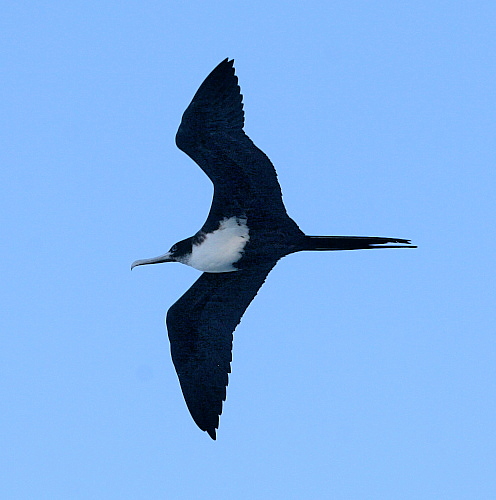
Adult Female Frigatebird at Pitcairn Island.
Head shot.
Juvenile Great Frigatebird at Pitcairn Island (CC)
Lesser Frigatebird - Fregata ariel
Just a single bird recorded.
Juvenile type Lesser Frigatebird, our only one of the trip. (CC).
Pacific Reef Heron – Egretta sacra
One seen on the 5th on Tahiti, 4 on the 17th and 2 on the 18th on Morane Island, which included
both white and dark colour phases.
Swamp Harrier – Circus approximans
Just a single bird seen on Tahiti, on the 5th.
Henderson Island Crake – Porzana atra
Three of these flightless crakes were found in the forests on Henderson Island on the 11th. Excellent
views obtained, with one searching for insects by flicking dead leaves up into the air in the manner of
a Pitta. Superb!! I am pleased to say that I found this first one. (JFC)
Considered Vulnerable by Birdlife International (2000), as it is only found on Henderson Island and is
flightless.

Habitat of the Henderson Island flightless Crake.


Feeding by flicking up leaves.
Henderson Island flightless Crake -1 of 3 seen on Henderson Island today. (CC).
Pacific Golden Plover – Pluvialis fulva
A party of 8 were seen from the plane as we landed on Hao Island en-route to Mangareva Island on the 6th.
Bristle Thighed Curlew – Numenius tahitensis
On Henderson Island, 10 were seen on the beach on the 10th with 30 there on the 11th. Four were
seen on the 17th on Morane Island, with a single here on the 18th.
Considered Vulnerable by Birdlife International (2000), due to its very small population
Of around 7,000 birds.
Bristle Thighed Curlews on Henderson Island.
On this last picture you can just see the so called bristles hanging down over the legs.
Bristle-thighed Curlew on Henderson Island (CC)
Wandering Tattler – Heteroscelus incanus
Five seen on Mangareva Island on the 6th with 1 there on the 19th & 20th. Singles seen on Pitcairn
Island on the 9th and Henderson Island on the 10th with 2 there on the 11th. Two seen on the 17th
on Morane Island. All birds identified were Wandering by their call and the wings just extending
beyond the tail tip..
Wandering Tattlers on Mangareva Island (CC).
Wandering Tattler on Mangareva Island.
wing tip extending just beyond the tail.
Wandering Tattler on Pitcairn Island. (CC).
Tuamotu Sandpiper – Prosobonia cancellata
Unable to land on Morane Island for close up views, but with the aid of the telescope, acceptable views
were obtained with 20 seen on the 17th and 30 on the 18th. Amazing in flight, which reminded me of a
tiny woodcock “roding”. Dark looking birds and strange to see them sat on branches and even on the
top of some tall trees.
Considered Endangered by Birdlife International (2000), due to its very small range.
A major disappointment when we were unable to land on Morane Island due to rough seas not allowing us to navigate through the coral reef, which surrounds this Island and we had to make do with telescope views from the deck of our boat outside of the reef, and Chris managed to obtain some long distant pictures.
Tuamotu Sandpiper on Morane Island. (CC)
(CC)
Tuamotu Sandpiper in flight. (CC)
South Polar Skua – Stercorarius maccormicki
One passed the ship at very close range on the 10th.
South Polar Skua - Our only sighting on this trip. (CC).
Great Crested Tern – Sterna bergii cristata
Six seen on Tahiti on the 5th, with 7 on Mangareva Island on the 6th, and 1 on the 19th. Four were
seen on Morane Island on the 17th with 2 on the 18th. It was much scarcer than I was expecting.
Crested Tern at Mangareva Island. (CC).
Sooty Tern – Sterna fuscata
Just seen on two dates with 10 on the 14th and 15 on the 17th. Like the previous species, much
scarcer than expected.
Sooty Terns - but always fairly distant off the boat.
Black Noddy – Anous minutus minutus
One seen on the 9th on Pitcairn Island, 2 on the 16th over the Portland Banks and one on the 18th
at Morane Island.
Brown Noddy – Anous stolidus pileatus
Recorded in low numbers on 8 dates, and again scarcer than expected. Daily maximum, of just 30 on
the 12th.
Blue Noddy – Proceisterna cerulea murphyi
The only ones identified for certain were in the Gambier Islands on the 19th, with 3 dark phase birds with the darker grey under-wings and at least 6 intermediate forms, very similar in plumage to the Grey Noddy.
On one occasion, we had an intermediate and a dark phase flying together for good comparison. Much
debate took place if this species is a good split, but on reference to Handbook of Birds of the World,
they consider that the split is valid
.

Blue Noddy types feeding in the Gambier Lagoon (CC).
Grey Noddy – Proceisterna albivitta skottsbergii
25 were seen on the cliffs on Pitcairn Island on the 9th, which included a very juvenile bird. Recent
literature has not included Pitcairn Island as a breeding site for this species.
One on Henderson on the 10th and 5 there on the 11th. Nine seen at Oneo Atoll on the 12th.
Grey Noddy on Pitcairn Island (CC).
White Tern – Gygis alba
By far the commonest Tern.and recorded on all but 2 dates with a daily maximum of 50 on several dates. The race “leucopes” was seen on both Henderson & Pitcairn Islands.
White Tern over Henderson Island. (CC)
White Tern on Pitcairn Island (CC)..
Zebra Dove – Geopelia striata
Very common on Tahiti on the 5th.
Grey Green Fruit Dove – Ptilinopus purpuratus purpuratus
Twenty were seen on Tahiti on the 5th.
Henderson Island Fruit Dove – Ptilinopus insularis
Just 3 were seen on Henderson Island on the 11th. One showed for almost 5 minutes at very close range. Superb!!
Considered Vulnerable by Birdlife International (2000) as it is only found on Henderson Island.
Endemic to Henderson Island (CC)
(CC)
(CC)

Henderson Island Fruit Dove - 1 of 3 seen on Henderson Island (CC)
Stephen’s Lorikeet – Vini stepheni
Six were seen on both the 10th and 11th on Henderson Island, chiefly only in flight, with only poor views of one perched.
Considered Vulnerable by Birdlife International (2000), as it is only found on Henderson Island.
Polynesian Swiftlet – Aerodramus leucophaeus
Twelve were seen in the Papehue Valley on Tahiti on the 5th including several visiting some caves in this valley. First discovered in 1923.
Considered Vulnerable by Birdlife International (2000), with a population of only 1,000 birds.
The Polynesian Swiftlet gorge in the Papehue Valley, Tahiti. (CC).
Tahiti Kingfisher – Todirhamphus veneratus
A pair showed very well along a wooded river valley on Tahiti on the 5th and others were heard calling. One of the birds caught a large green caterpillar, which it took about 5 minutes to eat.
Tahiti Kingfisher. (CC)
Red Vented Bulbul – Pycnonotus cafer
Very common on Tahiti on the 5th.
Tahiti Reed Warbler – Acrocephalus atyphus
Just a single bird, seen along a wooded valley on Tahiti on the 5th. The bird showed very well for about 5 minutes and was also heard calling. It had an extremely long bill.
Considered Vulnerable by Birdlife International (2000), with a small population of less than 1,000 birds.
Pitcairn Island Reed Warbler – Acrocephalus vaughani
Proved to be common on Pitcairn Island on the 12th with at least 16 different birds being seen, including a number of very pale individuals, although it proved to be very variable in plumage. To my eye, the bird appeared more Hippolais like than Acrocephalus.
Considered Vulnerable by Birdlife International (2000), as it is only found on Pitcairn Island.
Habitat of the Pitcairn Reed Warbler.(CC)
Pitcairn Reed Warblers.
Pitcairn Reed Warblers.

Pitcairn Reed Warblers one showing much browner wings the near bird showing
extensive white wings and tail (CC).
Pitcairn Reed Warbler showing the normal form with large areas of white on the wing.(CC)
Pitcairn Reed Warbler is an extremely variable Warbler with the amount of white in
both the wings and tail. Reasonable numbers were seen. (CC)
Henderson Island Reed Warbler – Acrocephalus taiti
We soon located 3 in thickets in a brief search on Henderson Island on the 11th. Appeared quite distinctive from the Pitcairn species and looked far more like an Acrocephalus.
Considered Vulnerable by Birdlife International (2000), as it is only found on Henderson Island.

Just my record shot of Henderson Island Reed-Warbler (JFC),
at least Chris did a lot better than myself, but they were not easy
to photograph.
Henderson Island Reed-Warbler - Three were seen. (CC).
Tahiti Monarch – Pomarea nigra
Just 2, an adult and an immature were found in the forest along the Papehue Valley on Tahiti on the 5th. They eventually gave good views, but kept to the mid-storey of the forests, although the immature did spend a short time on the side of a bank covered in ferns and other vegetation.
Considered Critical by Birdlife International (2000), due to a tiny population of about 20 birds. Although conservation action in recent years has prevented its extinction.
Silver-eye – Zosterops lateralis
Proved to be common on Tahiti on the 5th.
Common Myna – Acridotheres tristis
Very common on Tahiti on the 5th.
Common Waxbill – Estrilda astrild
Six were seen on Tahiti on the 5th.
Chestnut Breasted Munia – Lonchura castaneothorax
At least 15 were seen on Tahiti on the 5th, chiefly in gardens around the towns.
Other Items.
Crab on Mangareva. (CC).
Goat on Pitcairn (CC).
Fin or Sei Whale (CC).
Minke Whale (CC)
Catching dinner for tonight.
Fish in Mangareva harbour.
Small Shark in Mangareva harbour (CC)

 Arriving at the Papehue Valley Nature Reserve, Tahiti.
Arriving at the Papehue Valley Nature Reserve, Tahiti.



 Leaving Mangareva Harbour on the "Bounty Bay"
Leaving Mangareva Harbour on the "Bounty Bay" Sunset as we left Mangareva Island.
Sunset as we left Mangareva Island.
 Coastal Views of Pitcairn Island, with the sea looking rough, as we were going into land.
Coastal Views of Pitcairn Island, with the sea looking rough, as we were going into land. We transferred into the landing craft to land on Pitcairn.
We transferred into the landing craft to land on Pitcairn. The Landing Quay on Pitcairn.
The Landing Quay on Pitcairn.
 A Rough sea when departing to Pitcairn Island.
A Rough sea when departing to Pitcairn Island. Arriving at Henderson Island with a rough sea..
Arriving at Henderson Island with a rough sea..





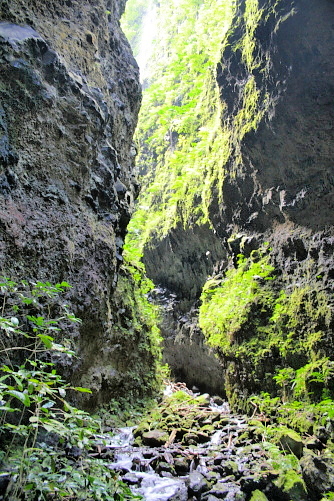





















+1.jpg)




































